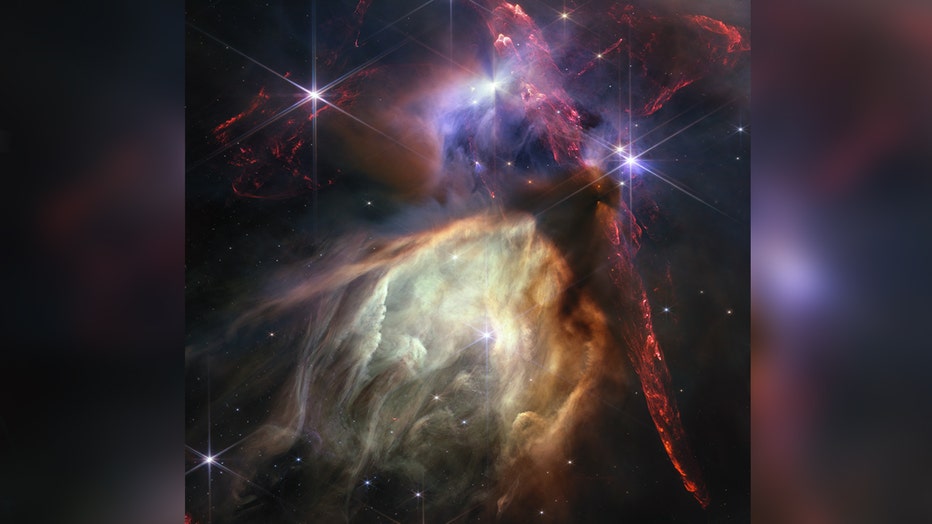NASA marks the James Webb Space Telescope’s first year of science with release of new image
New image from NASA's James Webb space telescope
One year ago, we saw the first images from the James Webb space telescope and it has continued to capture views of the 'early days' of the universe since then. NASA has shared a new image and said they are just getting started.
To celebrate the completion of the James Webb Space Telescope’s first year of science operations, NASA has released a close-up image of the birth of sun-like stars.
The image, captured on Webb’s telescope is a small star-forming region in the Rho Ophiuchi cloud complex – the nearest star-forming region to Earth.
The region’s proximity at 390 light-years allows for a highly detailed close-up, with no foreground stars in the intervening space.
"In just one year, the James Webb Space Telescope has transformed humanity’s view of the cosmos, peering into dust clouds and seeing light from faraway corners of the universe for the very first time. Every new image is a new discovery, empowering scientists around the globe to ask and answer questions they once could never dream of," said NASA administrator Bill Nelson. "Webb is an investment in American innovation but also a scientific feat made possible with NASA’s international partners that share a can-do spirit to push the boundaries of what is known to be possible. Thousands of engineers, scientists, and leaders poured their life’s passion into this mission, and their efforts will continue to improve our understanding of the origins of the universe – and our place in it."

The first anniversary image from NASA’s James Webb Space Telescope. (Credits: NASA, ESA, CSA, STScI, Klaus Pontoppidan (STScI))
According to NASA, Webb’s image shows a region containing approximately 50 young stars, all of them similar in mass to the Sun, or smaller. The darkest areas are the densest, where thick dust cocoons still-forming protostars.
See the latest stunning images taken by the James Webb Space Telescope
The James Webb Space Telescope has released more mesmerizing images of the deepest corners of our universe.
"On its first anniversary, the James Webb Space Telescope has already delivered upon its promise to unfold the universe, gifting humanity with a breathtaking treasure trove of images and science that will last for decades," said Nicola Fox, associate administrator of NASA’s Science Mission Directorate in Washington. "An engineering marvel built by the world’s leading scientists and engineers, Webb has given us a more intricate understanding of galaxies, stars, and the atmospheres of planets outside of our solar system than ever before, laying the groundwork for NASA to lead the world in a new era of scientific discovery and the search for habitable worlds."
Huge bipolar jets of molecular hydrogen, represented in red, dominate the image, appearing horizontally across the upper third and vertically on the right. NASA notes that these occur when a star first bursts through its natal envelope of cosmic dust, shooting out a pair of opposing jets into space like a newborn first stretching her arms out into the world.
James Webb telescope captures DART impact
The James Webb Space Telescope captured DART's impact on Sept. 26. (Credit: NASA, ESA, Jian-Yang Li (PSI); animation: Alyssa Pagan (STScI)).
Meanwhile, the star S1 has carved out a glowing cave of dust in the lower half of the image. It is the only star in the image that is significantly more massive than the Sun.
"Webb’s image of Rho Ophiuchi allows us to witness a very brief period in the stellar lifecycle with new clarity. Our own Sun experienced a phase like this, long ago, and now we have the technology to see the beginning of another’s star’s story," said Klaus Pontoppidan, who served as Webb project scientist at the Space Telescope Science Institute in Baltimore, Maryland, since before the telescope’s launch and through the first year of operations.
RELATED: 'Buried treasure': James Webb telescope’s newest images show star at birth
This new image comes one year after NASA revealed Webb’s very first deep-field image, which was unveiled by President Joe Biden and Vice President Kamala Harris at the White House.
"With a year of science under our belts, we know exactly how powerful this telescope is, and have delivered a year of spectacular data and discoveries," said Webb senior project scientist Jane Rigby of NASA's Goddard Space Flight Center. "We've selected an ambitious set of observations for year two — that builds on everything we've learned so far. Webb's science mission is just getting started — there's so much more to come."
The James Webb Space Telescope is the world's premiere space science observatory and an international program led by NASA with its partners, ESA (European Space Agency) and the Canadian Space Agency.
This story was reported from Los Angeles.

